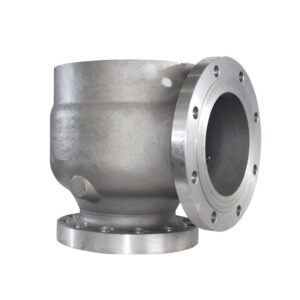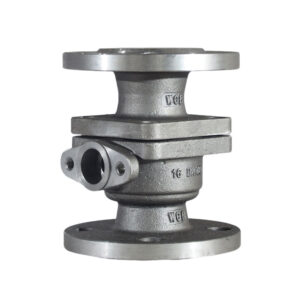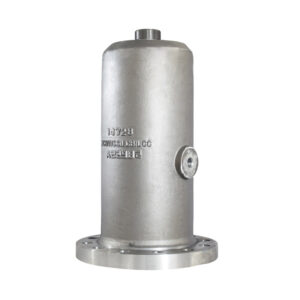جسم صمام الفحص الأوتوماتيكي الرأسي ذو الشفة
جسم صمام الفحص الأوتوماتيكي الرأسي ذو الشفة
عملية الصب: صب دقيق لسيليكا سول / صب رمل الراتنج معايير المظهر والتسامح الأبعادي وتسامح الوزن: وفقًا لمتطلبات العميل أنواع المواد: الفولاذ المقاوم للصدأ والفولاذ الخاص (وفقًا لمتطلبات العميل) وزن الصب المكون من قطعة واحدة: أقل من 300 كجم لصب دقيق لسيليكا سول / أقل من 708 كجم لصب رمل الراتنج.
عملية الصب: صب دقيق باستخدام سيليكا سول/صب رمل الراتنج
طريقة المعالجة: الخراطة العامة، CNC، مركز التشغيل الأفقي
تسامح المعالجة: ±0.05 مم (التحويل العام) ±0.02 مم (التحكم الرقمي بالحاسوب) ±0.05 مم (التصنيع الأفقي)
الحجم الأقصى: 1600 مم × 1000 مم × 1000 مم
نوع المعالجة: مركز تصنيع CNC رباعي المحاور
الشهادة: ISO9001:2023، DNV، CE
المعايير: معايير ASTM، DIN، JIS، EN، ISO، GB
مزايا شركة Leierwo في صب المسبوكات الدقيقة في صناعة صب الصمامات
تتمتع شركة لييروو بخبرة واسعة في مجال الصب الدقيق لسنوات عديدة، واكتسبت خبرة واسعة في تصنيع مكونات الصمامات. تتخصص الشركة في إنتاج مصبوبات دقيقة من الفولاذ الكربوني، وسبائك الفولاذ، والفولاذ المقاوم للصدأ، وهي مواد شائعة الاستخدام في صناعة الصمامات. باستخدام تقنيات متقدمة مثل الصب المنصهر وعمليات السيليكا سول، تتمكن الشركة من تحقيق صب عالي الدقة للأجزاء الهيكلية المعقدة، مما يلبي متطلبات أداء الصمامات في ظروف التشغيل عالية الحرارة والضغط ومقاومة التآكل. علاوة على ذلك، تُركز لييروو على الإنتاج المخصص بناءً على رسومات العملاء، مما يُمكّنها من مطابقة مصبوبات الصمامات بشكل أفضل مع احتياجات العملاء المحددة، مما يضمن إحكام المنتج واستقرار الهيكل.
اختيار المواد الرئيسية
يجب أن تتحمل مصبوبات الصمامات ظروف تشغيل معقدة، مثل الضغط ودرجة الحرارة والتآكل. لذلك، ينبغي أن يُعطى اختيار المواد الأولوية لمقاومة التآكل، ومقاومة درجات الحرارة العالية، ومقاومة التجويف، وقابلية المعالجة الجيدة. يُعد الفولاذ المقاوم للصدأ الخيار الأمثل نظرًا لأدائه العام الممتاز.
المواد الشائعة:
سلسلة الفولاذ المقاوم للصدأ:
316/316L: الخيار الأفضل، مقاوم لتآكل أيونات الكلوريد، مناسب للبيئات البحرية والصناعات الكيميائية والبترولية. 304/304L: مادة اقتصادية مناسبة للبيئات التآكلية العامة. 410: الفولاذ المقاوم للصدأ المارتنسيتي، مع بعض مقاومة التآكل، مناسب لصمامات البخار ذات درجات الحرارة العالية.
17-4PH: الفولاذ المقاوم للصدأ المقوى بالترسيب، ذو قوة عالية ومقاومة للتآكل، ومناسب للصمامات عالية الأداء.
سلسلة الفولاذ الكربوني:
WCB (مادة عامة من الفولاذ الكربوني): يستخدم عادة في الصمامات ذات الأغراض العامة في درجة حرارة الغرفة.
4130: مناسب لأغطية الصمامات ذات درجات الحرارة العالية والضغط العالي.
سلسلة سبائك متخصصة (لبيئات التآكل/درجات الحرارة العالية): فولاذ مقاوم للصدأ مزدوج 2205: يتميز بمقاومة ممتازة للتآكل الناتج عن الإجهاد، ومناسب للصناعات البحرية والكيميائية. سبائك الكوبالت (CoCr): مثل Co6 وCo12، مناسبة لأسطح إحكام الصمامات المعرضة لدرجات حرارة عالية شديدة التلف.
خيارات خدمة صب المفاتيح
تخضع الصمامات لمتطلبات صارمة فيما يتعلق بالإغلاق ومقاومة الضغط، ويؤثر اختيار خدمة الصب بشكل مباشر على موثوقيتها الوظيفية:
الصب الاستثماري: الطريقة المُفضّلة لصمامات الضغط المتوسط والعالي. غالبًا ما تحتوي مكونات، مثل أجسام الصمامات وقواعد الختم، على تجاويف داخلية مُعقّدة (مثل مسارات التدفق المُنحنية) وأسطح تزاوج دقيقة (على سبيل المثال، يجب أن تكون خشونة سطح الختم ≤ Ra1.6µm). يُمكن للصب الاستثماري استنساخ الأشكال المُعقّدة بدقة، وتقليل عيوب الصب (مثل المسام والانكماش)، والحدّ من مخاطر التسرب. وهو مُناسب بشكل خاص لصمامات الضغط العالي المصنوعة من الفولاذ المقاوم للصدأ والسبائك.
صب الرمل: مناسب للإنتاج الضخم للصمامات منخفضة الضغط وواسعة النطاق. على سبيل المثال، تتميز هياكل صمامات البوابة منخفضة الضغط المستخدمة في إمدادات المياه البلدية بأشكال بسيطة نسبيًا (هياكل متماثلة في الغالب)، ودورات إنتاج كبيرة، ومتطلبات دقة متوسطة. يوفر صب الرمل مزايا كبيرة من حيث التكلفة المنخفضة والقدرة الإنتاجية العالية.
التصنيع باستخدام الحاسب الآلي: يركز على نقاط الالتحام الحرجة. يجب أن تتوافق أقطار حواف الصمامات وأعمدة الساق بدقة مع خط الأنابيب أو المشغل. بعد الصب، تُجرى عمليات الطحن والتفريز باستخدام الحاسب الآلي لضمان استواء وتعامد لا يتجاوز 0.02 مم/م، مما يضمن تجميعًا محكمًا.





